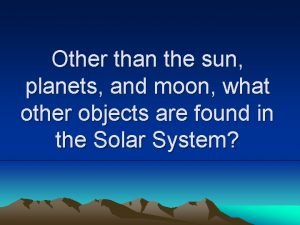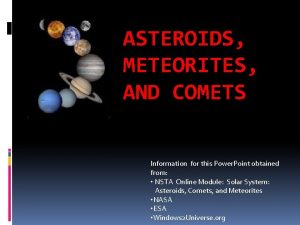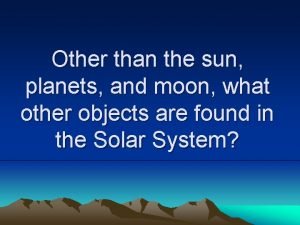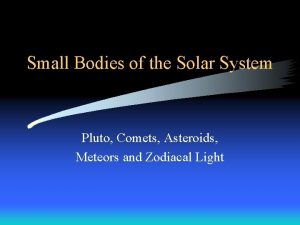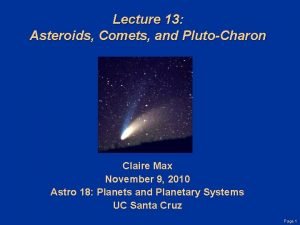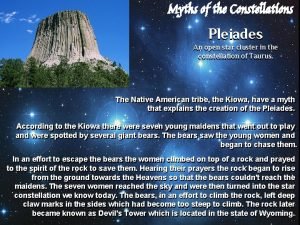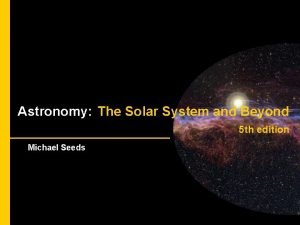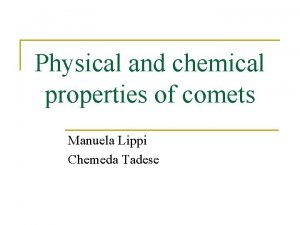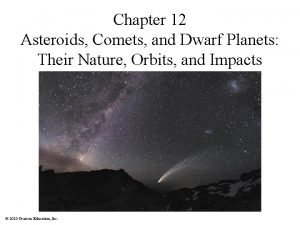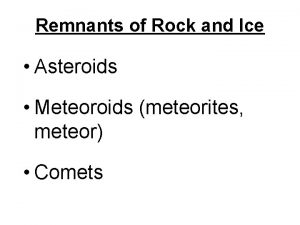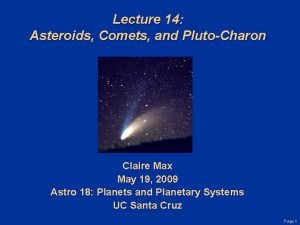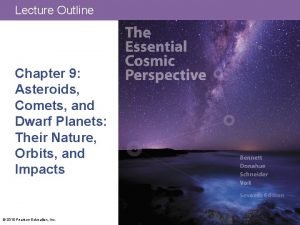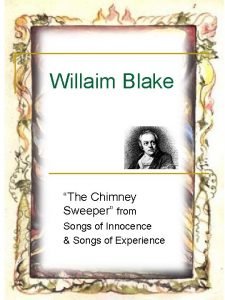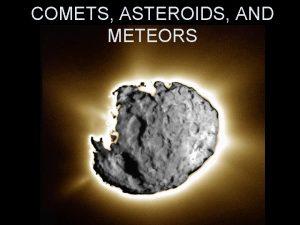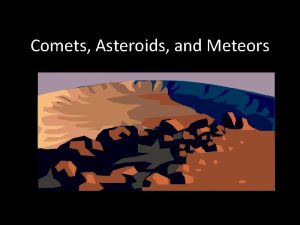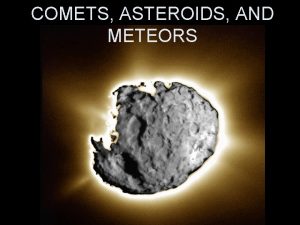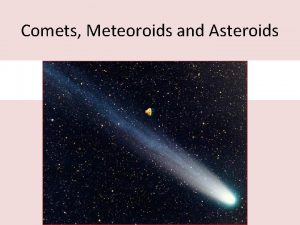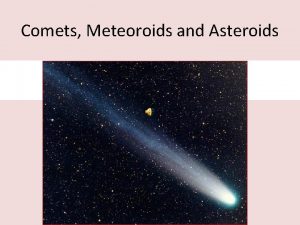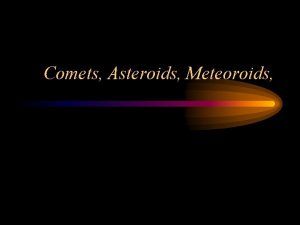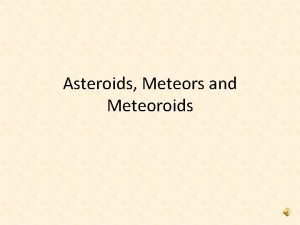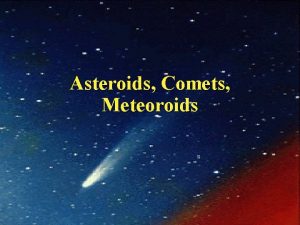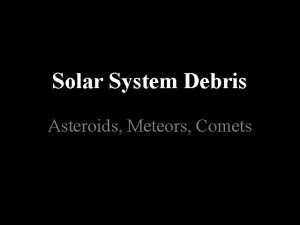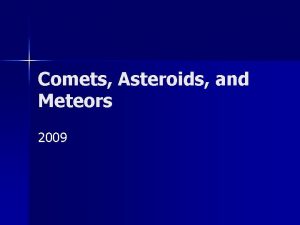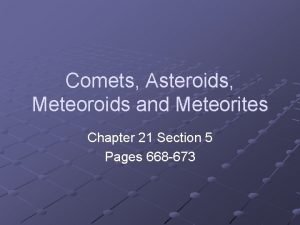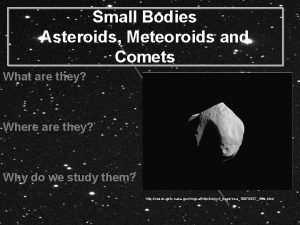Asteroids Comets and Meteors Asteroids Meteors Meteoroids and















- Slides: 15

Asteroids, Comets, and Meteors • Asteroids • Meteors, Meteoroids, and Meteorites • Comets

Asteroids • Small rocky objects that orbit the Sun • Billions of small rocky objects in a ring is called the ASTEROID BELT (between Mars and Jupiter) Pluto (no longer a planet) Neptune Uranus Saturn Jupiter Mars Earth Venus Mercury

Teach. With. Fergy Preview File Please enjoy this preview of your Student Version of the lesson. I’ve created this PDF for ease of viewing and to decrease the file size but of course, your lesson will be in Power. Point format. - Some slides appear blank because they have been removed. - Student versions have portions of the text removed which is given in the teacher version and appear as ______ - Other slides may have. . . on them, this represents writing that has been removed.

Asteroids • Size ranges from 6 meters to 933 km • ____________ EMBEDDED VIDEO HAS BEEN REMOVED Asteroid Impact – Dinosaur Killer

The Asteroid Belt • Most are small, boulder-size to a diameter of a few thousand feet • 7, 000 known • Largest have names: ………………. – Each at least 250 miles (400 km) long • Dwarf planet within: Ceres – 1/3 the mass of the whole belt • ______ • Asteroids widely spaced apart

Asteroid Composition • Three major types • C-type (carbonaceous): >75% of known asteroids – Contain large quantities of carbon • S-type (silicaceous): ~17% of known asteroids – Made of metallic iron with iron- and magnesiumsilicates • M-type (metallic): Most of the rest of the known asteroids – ______

THIS SLIDE HAS BEEN REMOVED

Meteors • ______ • They burn in the mesosphere. – 22 miles (35 km) thick – Above the highest altitude for planes – Below the lowest altitude for orbit • More gas molecules in mesosphere than layer above (thermosphere) • …………………. • Friction causes heat

Famous Meteors • Murchison, town in western Australia – – Sept. 28, 1969 Meteor exploded above Murchison Meteor older than the solar system Amino acids found in the meteor • Allende – Feb. 8, 1969 – Meteor landed in Chihuahua, MX – In 2012, found new mineral in Allende meteorite

Meteorite • A meteorite is a meteoroid or asteroid that ______ • Most are small • Size: pebble to boulder (up to 100 kg, 220 lbs) – Smaller than 2 mm: micrometeorite • 3 types – Stony: mostly silicate minerals (rock) – Iron: mostly metallic iron-nickel – Stony-iron: both rocky and metallic

February 2013 Meteor Explosion over Russia • The meteor had an initial mass of about 12, 000– 13, 000 metric tonnes (heavier than the Eiffel Tower), and measured between 17 and 20 meters in size (55 -65 feet). • It was moving at approximately ………………… • It exploded 23. 3 km above the ground, releasing the energy equivalent of 500 kilotons of TNT, 20– 30 times more energy than was released from the atomic bomb detonated at Hiroshima (but without the radiation). • The explosion created a shockwave, shattering windows, toppling smaller structures, and injuring thousands. EMBEDDED VIDEO HAS BEEN REMOVED

THIS SLIDE HAS BEEN REMOVED

THIS SLIDE HAS BEEN REMOVED

Comets • Comets have been around since the formation of our solar system • They give us clues about how that formation happened • ______

Halley’s Comet • Most famous comet • Passes by Earth about every 75 years 164 BC 1682 240 BC 1759 1835 1066 1910 1305 1986
 What is the difference between meteors and comets
What is the difference between meteors and comets Difference between comets and asteroids and meteors
Difference between comets and asteroids and meteors Asteroids meteors and comets worksheet
Asteroids meteors and comets worksheet Comets asteroids
Comets asteroids A rocky leftover planetesimal orbiting the sun is
A rocky leftover planetesimal orbiting the sun is Comets diagram
Comets diagram Origin of meteors
Origin of meteors Physical properties of comets
Physical properties of comets Origin of asteroids
Origin of asteroids Asteroids
Asteroids An icy leftover planetesimal orbiting the sun is
An icy leftover planetesimal orbiting the sun is Jupiter nudges the asteroids through the influence of
Jupiter nudges the asteroids through the influence of Red orange yellow green blue purple brown black white gray
Red orange yellow green blue purple brown black white gray Willaim blake
Willaim blake West side story vs romeo and juliet
West side story vs romeo and juliet Shorter and older taller and younger
Shorter and older taller and younger
